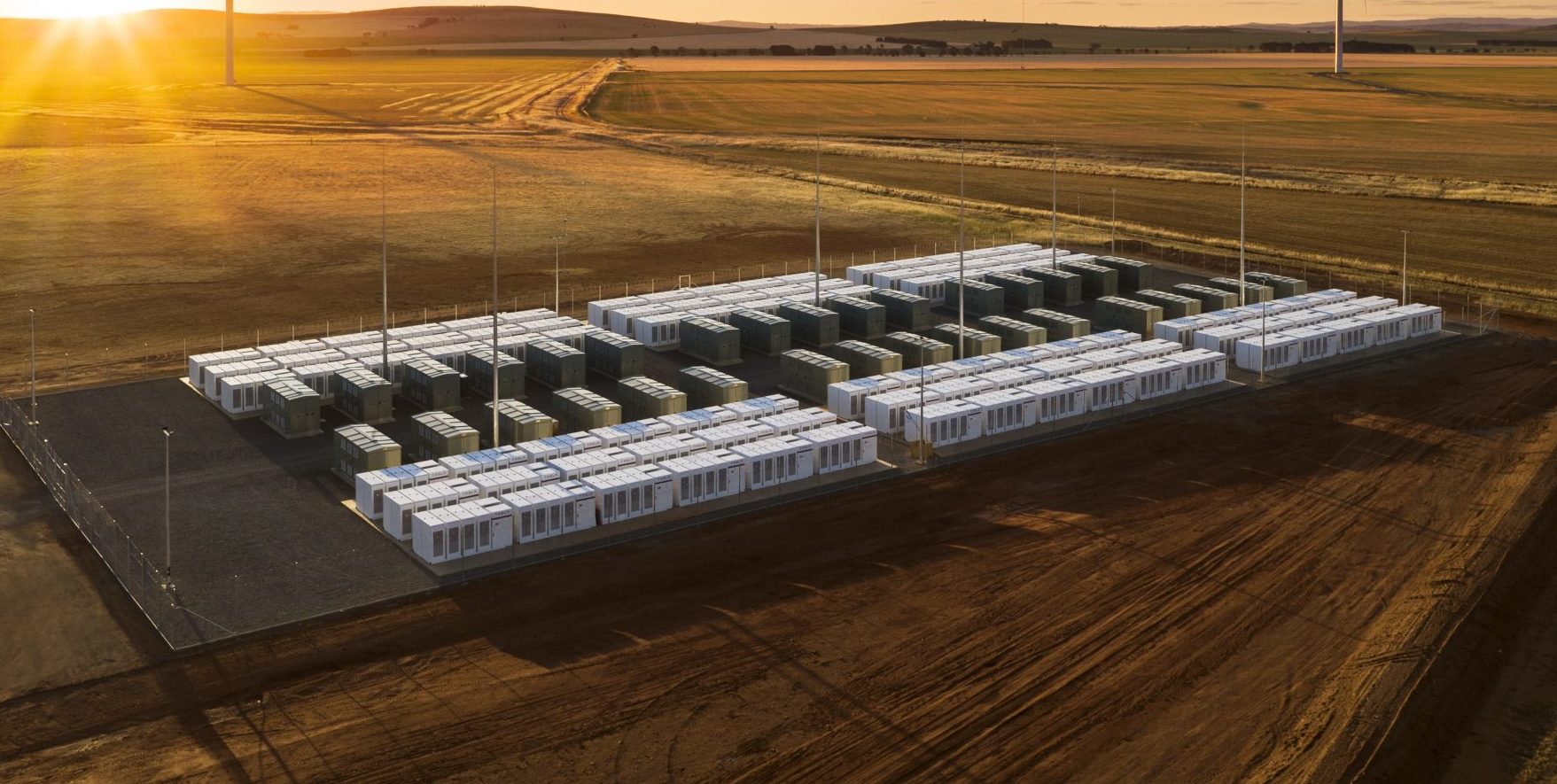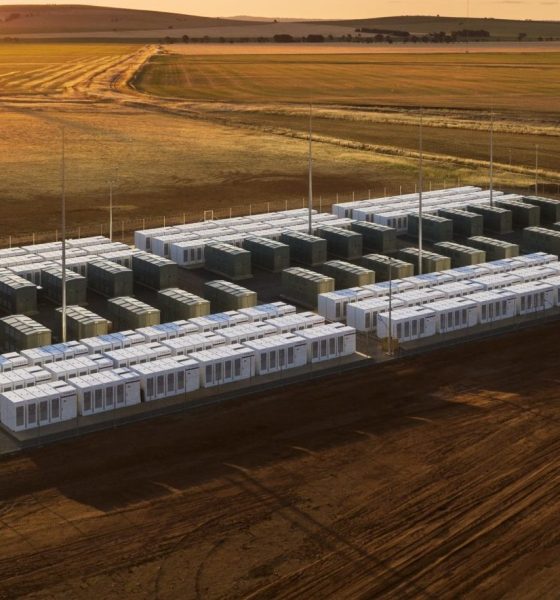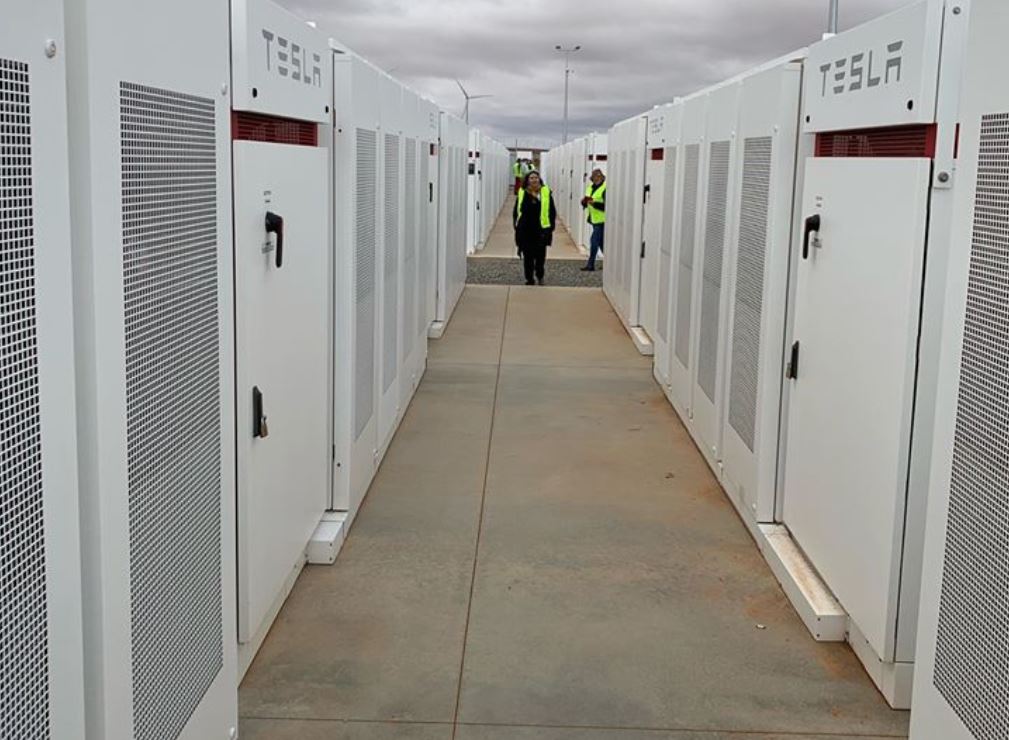

Energy
Tesla “big battery” in Australia is becoming a bigger nightmare for fossil fuel power generators
Tesla’s “big battery” utility-scale Powerpack system at the Hornsdale Power Reserve in South Australia has yielded more than doubled the savings to consumers in 2019 than the year prior as it dominates fossil fuel generators on quicker demand response for the grid.
Hornsdale Power Reserve saved consumers AUD116 million ($75.78 million) in 2019, a big jump from AUD40 million ($26.14 million) savings in 2018.
The Hornsdale Power Reserve, owned and operated by French renewable energy producer Neoen, is home to the largest lithium-ion battery energy storage system in the world with a 100 MW/129 MWh. Tesla Powerpack has been playing a significant role in grid stability since its installation in 2017, a function previously dominated by fossil fuel generators that bring energy prices high during system faults of planned maintenance.
“Hornsdale has just been the best asset for the state, and for us as well, it’s a real success story,” head of development at Neoen Australia Garth Heron said in an interview with RenewEconomy. We have shown that these kinds of systems can work. It saves consumers a lot of money, and it’s something we should be rolling out right across the market.”

The system that covers approximately one hectare of land at the Hornsdale Wind Farm provides grid stability to consumers, storing excess energy during off-peak periods and supplying the grid when renewable outputs are low. When a power plant goes down or when there is greater demand for energy, it is practically a race to meet that demand. Tesla battery-powered HPR beats power providers dependent on fossil fuel and gives consumers a win-win scenario. Consumers benefit from the lower prices of HPR and blackouts that can disrupt businesses or daily household activities are avoided. As South Australia shifts to renewable energy, fossil fuel power generators that did not have potent competition before in the market are now forced to bring their prices down back from the orbit.
A report by Australian consulting firm Aurecon analyzed the impact of the Tesla big battery at Hornsdale Power Reserve in its role in the Frequency Control and Ancillary Services (FCAS) markets. These are basically events that require quick reactions when there are sudden changes in demand or supply.
For example, when the Australian Energy Market Operator called for 35MW of FCAS in January, the Tesla big battery was quick to respond and kept prices reasonable. The prices were as low as AUD270 ($176)/MW instead of hitting AUD11,500($7,511)/MW to AUD14,000($9,143)/MW if supplied by the fossil fuel-dependent generators. When South Australia was “islanded” because of a major outage in Victoria, the HPR was able to save consumers AUD14 million in five hours.
According to Aurecon, the biggest savings came from the raised FCAS and amounted to more than AUD50 million ($32.65 million).
The Hornsdale Power Reserve also has a significant impact on FCAS market regulation. Tesla battery use has pushed the average prices from AUD450 ($294)/MWh two years before the installation of HPR to just over AUD20 ($13)/MWH. With lower prices, battery-generated power practically brought fossil fuel power plants, that ruled the region like cartels, to their knees.
Tesla battery has demonstrated how lithium-ion battery power reserves can play a big role in the security of the overall grid. While fuel fossil-powered generators will take several minutes to feed power to the grid in need, the HPR’s fast-discharge capability beat these options and give consumers access to more affordable energy. This also bodes well for owner and operator Neoen to make most of the potential returns, and of course, for Tesla’s energy business.
Tesla’s big battery has proven that battery storage is a practical option on a grid-scale. And it’s very profitable. The state government only injected AUD4 million ($2.61 million) into the multi-million project.
During the final quarter of 2019, the revenue of the Hornsdale Power Reserve jumped by 56%.
The HPR also announced plans to expand its capacity by 50%, boosting it by 50MW/64.5MWh. The project is expected to be completed in the first half of 2020 and will provide stabilizing inertia services critical to the shift to renewable energy in the region, and help push Australia closer to its goal of being net 100% renewable by 2030.
With the numbers clearly showing the benefits of Tesla’s big battery, it is not just a big banana as Australian prime minister Scott Morrison once said.

Cybertruck
Tesla updates Cybertruck owners about key Powershare feature

Tesla is updating Cybertruck owners on its timeline of a massive feature that has yet to ship: Powershare with Powerwall.
Powershare is a bidirectional charging feature exclusive to Cybertruck, which allows the vehicle’s battery to act as a portable power source for homes, appliances, tools, other EVs, and more. It was announced in late 2023 as part of Tesla’s push into vehicle-to-everything energy sharing, and acting as a giant portable charger is the main advantage, as it can provide backup power during outages.
Cybertruck’s Powershare system supports both vehicle-to-load (V2L) and vehicle-to-home (V2H), making it flexible and well-rounded for a variety of applications.
However, even though the feature was promised with Cybertruck, it has yet to be shipped to vehicles. Tesla communicated with owners through email recently regarding Powershare with Powerwall, which essentially has the pickup act as an extended battery.
Powerwall discharge would be prioritized before tapping into the truck’s larger pack.
However, Tesla is still working on getting the feature out to owners, an email said:
“We’re writing to let you know that the Powershare with Powerwall feature is still in development and is now scheduled for release in mid-2026.
This new release date gives us additional time to design and test this feature, ensuring its ability to communicate and optimize energy sharing between your vehicle and many configurations and generations of Powerwall. We are also using this time to develop additional Powershare features that will help us continue to accelerate the world’s transition to sustainable energy.”
Owners have expressed some real disappointment in Tesla’s continuous delays in releasing the feature, as it was expected to be released by late 2024, but now has been pushed back several times to mid-2026, according to the email.
Foundation Series Cybertruck buyers paid extra, expecting the feature to be rolled out with their vehicle upon pickup.
Cybertruck’s Lead Engineer, Wes Morrill, even commented on the holdup:
As a Cybertruck owner who also has Powerwall, I empathize with the disappointed comments.
To their credit, the team has delivered powershare functionality to Cybertruck customers who otherwise have no backup with development of the powershare gateway. As well as those with solar…
— Wes (@wmorrill3) December 12, 2025
He said that “it turned out to be much harder than anticipated to make powershare work seamlessly with existing Powerwalls through existing wall connectors. Two grid-forming devices need to negotiate who will form and who will follow, depending on the state of charge of each, and they need to do this without a network and through multiple generations of hardware, and test and validate this process through rigorous certifications to ensure grid safety.”
It’s nice to see the transparency, but it is justified for some Cybertruck owners to feel like they’ve been bait-and-switched.
Energy
Tesla starts hiring efforts for Texas Megafactory
Tesla’s Brookshire site is expected to produce 10,000 Megapacks annually, equal to 40 gigawatt hours of energy storage.

Tesla has officially begun hiring for its new $200 million Megafactory in Brookshire, Texas, a manufacturing hub expected to employ 1,500 people by 2028. The facility, which will build Tesla’s grid-scale Megapack batteries, is part of the company’s growing energy storage footprint.
Tesla’s hiring efforts for the Texas Megafactory are hinted at by the job openings currently active on the company’s Careers website.
Tesla’s Texas Megafactory
Tesla’s Brookshire site is expected to produce 10,000 Megapacks annually, equal to 40 gigawatt hours of energy storage, similar to the Lathrop Megafactory in California. Tesla’s Careers website currently lists over 30 job openings for the site, from engineers, welders, and project managers. Each of the openings is listed for Brookshire, Texas.
The company has leased two buildings in Empire West Business Park, with over $194 million in combined property and equipment investment. Tesla’s agreement with Waller County includes a 60% property tax abatement, contingent on meeting employment benchmarks: 375 jobs by 2026, 750 by 2027, and 1,500 by 2028, as noted in a report from the Houston Business Journal. Tesla is required to employ at least 1,500 workers in the facility through the rest of the 10-year abatement period.
Tesla’s clean energy boom
City officials have stated that Tesla’s arrival marks a turning point for the Texas city, as it highlights a shift from logistics to advanced clean energy manufacturing. Ramiro Bautista from Brookshire’s economic development office, highlighted this in a comment to the Journal.
“(Tesla) has great-paying jobs. Not just that, but the advanced manufacturing (and) clean energy is coming to the area,” he said. “So it’s not just your normal logistics manufacturing. This is advanced manufacturing coming to this area, and this brings a different type of job and investment into the local economy.”
Energy
Tesla and Samsung SDI in talks over new US battery storage deal: report
The update was related by industry sources and initially reported by South Korean news outlets.

Recent reports have suggested that Tesla and Samsung SDI are in talks over a potential partnership to supply batteries for large-scale energy storage systems (ESS).
The update was related by industry sources and initially reported by South Korean news outlets.
ESS batteries to be built at Samsung’s Indiana plant
As noted in a report from Korea JoongAng Daily, the demand for energy storage systems has been growing rapidly in North America, thanks in no small part to the surge in AI investments across numerous companies. With this in mind, Tesla has reportedly approached Samsung SDI about a potential battery supply deal.
The deal is reportedly worth over 3 trillion Korean won (approximately $2.11 billion) and will span three years, according to The Korea Global Economic Daily. A battery supply deal with Samsung SDI could make sense for Tesla as the company already has a grid-scale battery, the Megapack, which is perfect for industrial use. Samsung SDI could simply supply cells for the EV maker.
Production of the batteries would reportedly take place at Samsung SDI’s joint venture factory with Stellantis in Indiana, which is currently under construction. Samsung SDI recently announced plans to use part of that plant’s EV lines to produce cells for ESS, with a targeted capacity of 30 GWh by the end of next year.
Tesla and Samsung’s partnership
At present, only a handful of manufacturers, including Korea’s LG Energy Solution, Samsung SDI, SK On, and Japan’s Panasonic, are capable of producing energy storage-scale batteries domestically in the United States. A Samsung SDI official issued a comment about the matter, stating, “Nothing has been finalized regarding cooperation with Tesla.”
The possible energy storage system deal adds another layer to Tesla’s growing collaboration with Samsung, which is already in line as a partner in the upcoming production of Tesla’s AI5 and AI6 chips. Early sample manufacturing of the AI6 is expected to begin in South Korea, with mass production slated for Samsung’s Texas-based Taylor foundry when it starts operations.
The AI6 chip will power Tesla’s next wave of high-volume projects, including the Optimus humanoid robot and the autonomous Cybercab service. Musk has called the partnership with Samsung a “real collaboration,” adding that he personally plans to “walk the line” at the Taylor facility to speed up progress.








